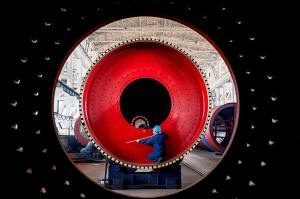China's weak factory PMI exposes pain points in export juggernaut
 Send a link to a friend
Send a link to a friend
 [July 31, 2024] By
Joe Cash [July 31, 2024] By
Joe Cash
BEIJING (Reuters) - China's manufacturing activity slipped to a
five-month nadir in July as factories grappled with falling new orders
and low prices, an official survey showed on Wednesday, pointing to a
grinding second half for the world's production powerhouse.
The National Bureau of Statistics (NBS) purchasing managers' index (PMI)
contracted for a third month, easing to 49.4 from 49.5 in June, below
the 50-mark separating growth from contraction, but just ahead of a
median forecast of 49.3 in a Reuters poll.
Sentiment remains gloomy among manufacturers as domestic demand is
increasingly under siege and external pressures from trade tensions loom
large for China's $18.6 trillion economy, which grew more slowly than
expected in the second quarter.
Producers reported factory gate prices were at their worst in 13 months,
while employment stayed in negative territory, with its sub-index last
expanding in February 2023 and pointing to a somnolent domestic economy
and China's increasing reliance on exports for momentum.
Solace could not be found in July's new export orders sub-index, which
contracted for a third month and suggested factory owners had continued
to slash prices to propel outbound shipments.

Furthermore, hopes that strong exports would spark a broader economic
recovery were dashed by extreme weather conditions, as flooding and high
temperatures hurt production lines over July, NBS senior statistician
Zhao Qinghe said.
Policymakers, however, have been seemingly slow to recognise the
magnitude of the economy's mounting afflictions.
"The only silver lining is that the recent loss of momentum appears to
have made officials more serious about turning up the gears of near-term
policy support," said Gary Ng, assistant economist at Capital Economics,
adding that it "should underpin a recovery in activity in the coming
months."
Consumers have cut back spending on big-ticket items and shied away from
premium-priced goods. Car sales, the biggest component of China's retail
sales, fell for the third month in June. Starbucks, which has thousands
of stores across its second-largest market, reported a 14% plunge in
quarterly China sales as coffee drinkers gravitated to cheaper
offerings.
Policymakers promised further stimulus to encourage low- and
middle-income groups to spend more during a meeting of the top-decision
making body of the ruling Communist Party on Tuesday, but stopped short
of announcing specific steps.
[to top of second column] |

An employee measures a newly manufactured ball mill machine at a
factory in Nantong, Jiangsu province, China June 28, 2019. Picture
taken through a ball mill machine June 28, 2019. REUTERS/Stringer

Analysts said that measures to support household comsumption were
unlikely to meaningfully boost the economic recovery.
China's state planner announced that half of the 300 billion yuan
($41.40 billion) to be issued in ultra-long treasury bonds will be
allocated to support a consumer trade-ins programme, but that amount
is equivalent to just 0.12% of economic output and 0.3% of 2023's
retail sales.
NO MAJOR NEW STIMULUS
One of the main reasons people are not spending in China is 70% of
household wealth is held in real estate, and house prices fell at
their fastest pace in nine years in June.
That problem is compounded by the fact that the property sector used
to constitute around one quarter of the economy, making it a key
growth driver.
But the PMI's construction sub-index grew more slowly in July,
pointing to diminishing demand for new apartments and other building
projects.
The official non-manufacturing purchasing managers' index (PMI),
which includes services and construction, slowed to 50.2 in July
from 50.5 a month prior.
Analysts were divided over the extent to which policymakers would
reconsider stronger stimulus as the economy continues to show few
signs of a turnaround.
Wang Tao, UBS chief China economist and head of Asia economics, said
further cuts to the amount commercial banks must hold in reserve and
lower borrowing costs could be on the cards, but did not see
policymakers picking up a new playbook.
"We expect modest policy support ahead in the rest of 2024, which
may largely follow through previous policy settings in the past
several months, but with no major new stimulus," she added.
(Reporting by Joe Cash; Editing by Jacqueline Wong)
[© 2024 Thomson Reuters. All rights
reserved.]
This material may not be published,
broadcast, rewritten or redistributed.
Thompson Reuters is solely responsible for this content.
 |